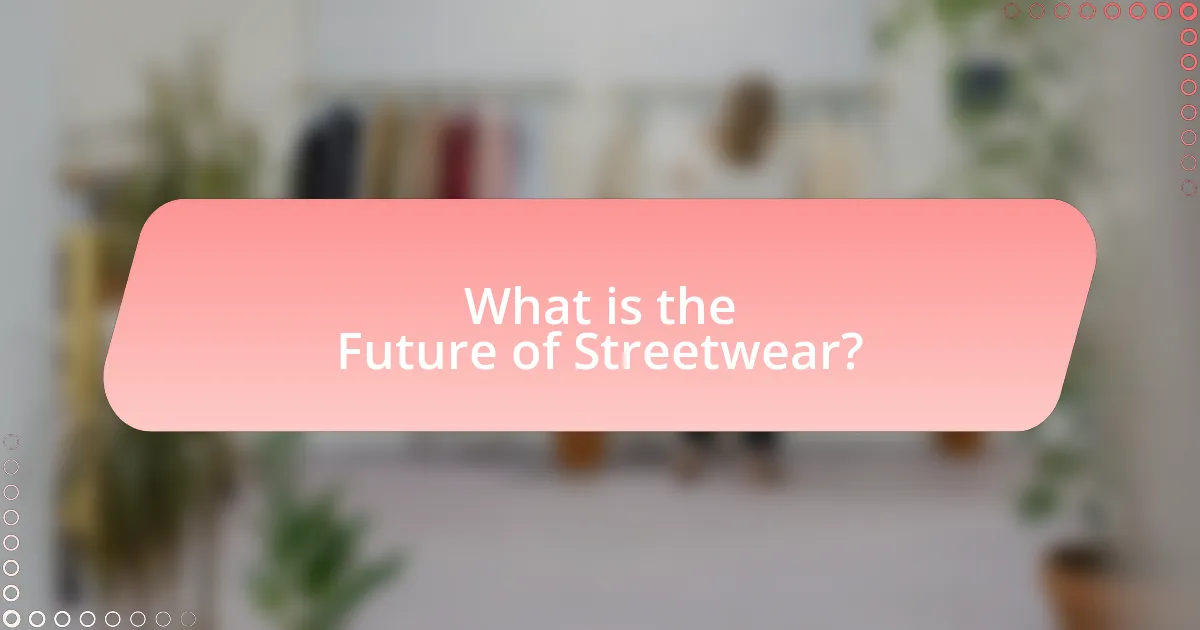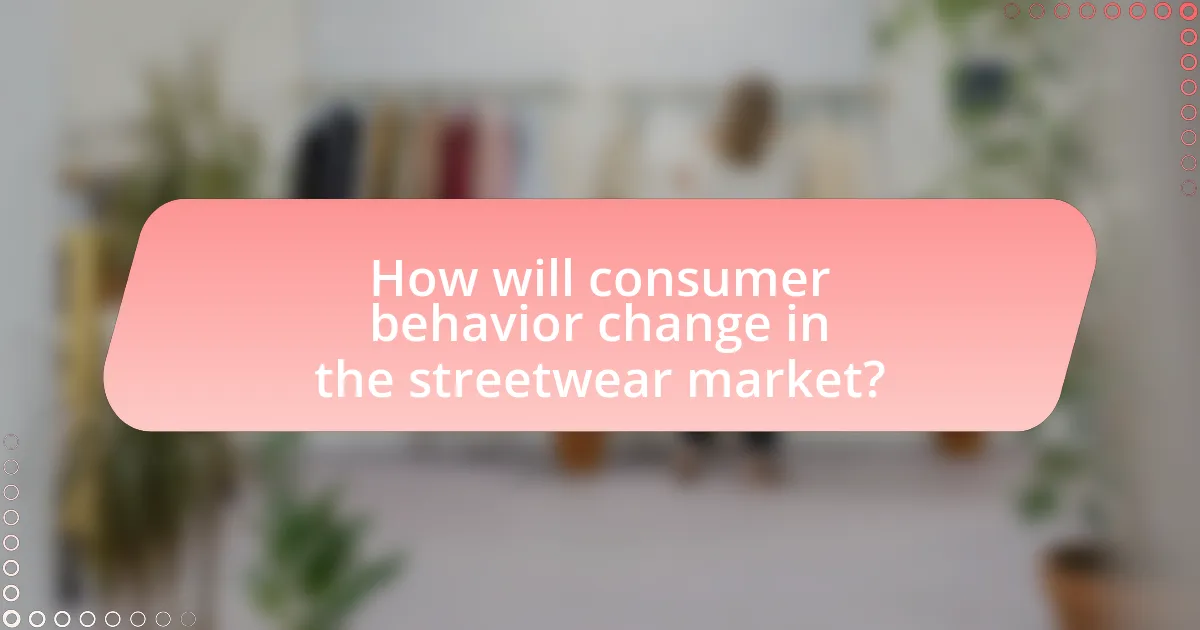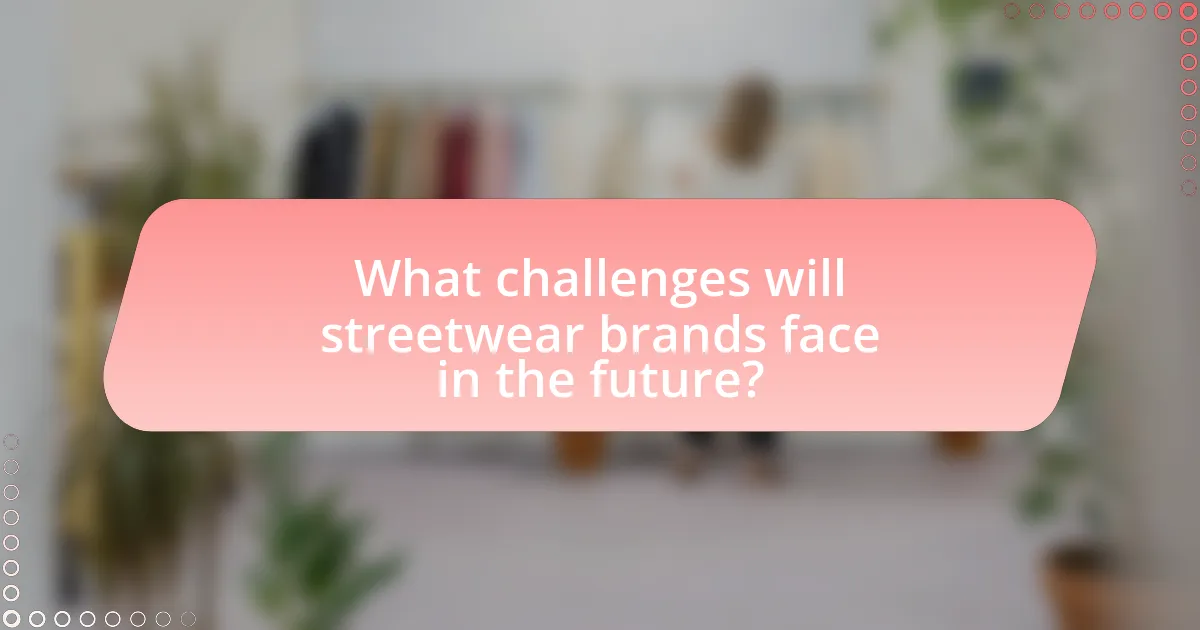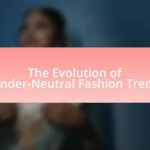The article examines the future of streetwear, predicting significant shifts over the next five years towards sustainability, inclusivity, and technological integration. It highlights the increasing consumer demand for eco-friendly practices and ethical production, as well as the influence of digital fashion and social media on trends. Key trends include the rise of collaborations between streetwear and luxury brands, the impact of celebrity endorsements, and the evolving resale market driven by authenticity and consumer preferences. The article also addresses the challenges brands will face, such as market saturation and the need for ethical considerations in production practices.

What is the Future of Streetwear?
The future of streetwear is expected to evolve towards greater sustainability, inclusivity, and technological integration. As consumer awareness of environmental issues increases, brands are likely to adopt eco-friendly materials and ethical production practices, reflecting a shift seen in recent years where 60% of consumers prioritize sustainability in their purchasing decisions. Additionally, the rise of digital fashion and virtual reality experiences will likely influence streetwear, as evidenced by the growing popularity of virtual clothing in online platforms and gaming environments. This trend indicates that streetwear will not only remain relevant but will also adapt to the changing landscape of consumer preferences and technological advancements.
How is streetwear evolving in the current fashion landscape?
Streetwear is evolving by increasingly integrating high fashion elements and sustainability practices into its core. This shift is evident as luxury brands collaborate with streetwear labels, exemplified by partnerships like Louis Vuitton and Off-White, which blur the lines between casual and high-end fashion. Additionally, consumer demand for eco-friendly materials is prompting streetwear brands to adopt sustainable practices, with companies like A Bathing Ape introducing recycled fabrics. This evolution reflects a broader trend in the fashion landscape where inclusivity and environmental consciousness are becoming essential, aligning streetwear with contemporary cultural values.
What cultural influences are shaping the future of streetwear?
Cultural influences shaping the future of streetwear include globalization, social media, and sustainability. Globalization allows for the blending of diverse cultural aesthetics, leading to unique streetwear designs that draw from various global influences. Social media platforms, particularly Instagram and TikTok, facilitate rapid trend dissemination and community engagement, enabling brands to connect directly with consumers and adapt quickly to their preferences. Additionally, the growing emphasis on sustainability drives brands to adopt eco-friendly materials and ethical production practices, reflecting consumers’ increasing awareness of environmental issues. These influences collectively redefine streetwear, making it more inclusive, responsive, and responsible.
How do technological advancements impact streetwear trends?
Technological advancements significantly influence streetwear trends by enabling innovative design processes, enhancing consumer engagement, and facilitating rapid production cycles. For instance, advancements in 3D printing allow designers to create unique, customizable pieces that cater to individual preferences, thereby driving demand for personalized streetwear. Additionally, the rise of social media platforms and e-commerce technologies has transformed how brands market their products, allowing for real-time feedback and trend analysis. This shift has led to a more agile response to consumer preferences, as brands can quickly adapt their offerings based on data-driven insights. Furthermore, technologies like augmented reality (AR) and virtual reality (VR) are being integrated into shopping experiences, providing immersive ways for consumers to interact with streetwear brands. These technological integrations not only enhance the shopping experience but also shape the aesthetic and cultural narratives surrounding streetwear, making it more dynamic and responsive to societal changes.
What are the key trends expected in streetwear over the next five years?
Key trends expected in streetwear over the next five years include increased sustainability, the rise of digital fashion, and a focus on inclusivity. Sustainability will become a priority as brands adopt eco-friendly materials and ethical production practices, responding to consumer demand for environmentally responsible fashion. The digital fashion trend will gain momentum as virtual clothing and NFTs become more mainstream, allowing for innovative expressions of style in online spaces. Additionally, inclusivity will shape streetwear, with brands expanding their size ranges and promoting diverse representations in marketing campaigns, reflecting a broader societal push for equality and representation in fashion.
Which styles and aesthetics are predicted to dominate?
Streetwear is predicted to be dominated by a blend of retro influences, sustainable practices, and digital aesthetics over the next five years. This forecast is supported by the growing consumer demand for nostalgic designs, as evidenced by the resurgence of 90s and early 2000s fashion trends in recent collections from major brands. Additionally, sustainability is becoming a key focus, with brands like Patagonia and Stella McCartney leading the way in eco-friendly materials and ethical production methods. Furthermore, the rise of digital fashion, particularly in virtual environments and metaverse platforms, indicates a shift towards more experimental and tech-driven aesthetics, as seen in collaborations between fashion houses and digital artists.
How will sustainability influence streetwear brands?
Sustainability will significantly influence streetwear brands by driving them to adopt eco-friendly materials and ethical production practices. As consumer awareness of environmental issues increases, brands are pressured to reduce their carbon footprint and utilize sustainable resources, such as organic cotton and recycled polyester. For instance, a report by McKinsey & Company highlights that 67% of consumers consider sustainability when making a purchase, indicating a clear market demand for responsible fashion. Consequently, streetwear brands that prioritize sustainability are likely to enhance their brand loyalty and attract a growing segment of environmentally conscious consumers.
What role do collaborations play in the future of streetwear?
Collaborations are essential for the future of streetwear as they drive innovation, expand brand reach, and enhance consumer engagement. By partnering with diverse brands, artists, and influencers, streetwear labels can create unique products that blend different aesthetics and cultures, appealing to a broader audience. For instance, the collaboration between Nike and Off-White has not only generated significant sales but also reshaped consumer perceptions of both brands, demonstrating the power of strategic partnerships. Furthermore, collaborations often leverage social media and influencer marketing, which are crucial for reaching younger demographics, thus ensuring the continued relevance and growth of streetwear in a competitive market.
How are brands leveraging partnerships to innovate?
Brands are leveraging partnerships to innovate by collaborating with other companies, artists, and influencers to create unique products and experiences. For instance, streetwear brands often team up with high-fashion labels or popular cultural icons to blend styles and reach new audiences, resulting in limited-edition collections that generate buzz and drive sales. A notable example is the collaboration between Nike and Off-White, which led to the “The Ten” collection, significantly impacting both brands’ visibility and market share. This strategy not only enhances creativity but also allows brands to tap into each other’s customer bases, fostering growth and innovation in the competitive streetwear market.
What impact do celebrity endorsements have on streetwear trends?
Celebrity endorsements significantly influence streetwear trends by driving consumer interest and shaping brand perceptions. When high-profile celebrities promote specific streetwear brands or styles, they create a sense of desirability and exclusivity, which can lead to increased sales and brand loyalty. For instance, collaborations between celebrities and streetwear labels, such as Kanye West’s partnership with Adidas for the Yeezy line, have resulted in substantial market shifts and heightened visibility for the brands involved. According to a study by the NPD Group, 70% of consumers reported that celebrity endorsements impact their purchasing decisions, highlighting the effectiveness of this marketing strategy in the streetwear sector.

How will consumer behavior change in the streetwear market?
Consumer behavior in the streetwear market will increasingly prioritize sustainability and ethical production. As awareness of environmental issues grows, consumers are shifting towards brands that demonstrate commitment to eco-friendly practices and social responsibility. A report by McKinsey & Company indicates that 67% of consumers consider sustainability when making a purchase, highlighting a significant trend towards conscious consumerism in fashion. Additionally, the rise of digital engagement and social media influence will further shape purchasing decisions, as consumers seek authenticity and connection with brands that resonate with their values.
What factors are driving consumer preferences in streetwear?
Consumer preferences in streetwear are primarily driven by cultural influences, brand authenticity, and social media engagement. Cultural influences stem from music, art, and youth subcultures, which shape the aesthetic and values associated with streetwear. Brand authenticity is crucial, as consumers favor brands that resonate with their identity and values, often preferring those with a genuine story or heritage. Social media engagement plays a significant role, as platforms like Instagram and TikTok facilitate trends and allow consumers to connect with brands and influencers, amplifying their preferences. According to a 2021 report by McKinsey & Company, 70% of consumers are influenced by social media when making fashion purchases, highlighting its impact on streetwear preferences.
How does social media influence purchasing decisions?
Social media significantly influences purchasing decisions by shaping consumer perceptions and behaviors through targeted advertising, peer recommendations, and influencer endorsements. Research indicates that 54% of social media users utilize these platforms to research products before making a purchase, highlighting the role of social media in the decision-making process. Additionally, a study by the American Marketing Association found that consumers are 71% more likely to make a purchase based on social media referrals, demonstrating the direct impact of social media interactions on buying behavior.
What demographic shifts are affecting streetwear consumption?
The demographic shifts affecting streetwear consumption include the increasing influence of Gen Z and millennials, who prioritize sustainability and inclusivity in their purchasing decisions. These younger consumers are driving demand for brands that align with their values, leading to a rise in eco-friendly materials and diverse representation in marketing. According to a 2021 report by McKinsey & Company, 67% of consumers consider the use of sustainable materials to be important when making fashion purchases, highlighting the shift towards environmentally conscious consumption among younger demographics. Additionally, urbanization and the growth of online shopping have expanded access to streetwear, further influencing consumption patterns.
How will the resale market evolve in the next five years?
The resale market will experience significant growth and diversification over the next five years. This evolution will be driven by increasing consumer demand for sustainable fashion, with a projected market size of $64 billion by 2024, according to a report by ThredUp. Additionally, technological advancements such as blockchain for authentication and AI for pricing will enhance trust and efficiency in transactions. The rise of social media platforms as marketplaces will further facilitate access to resale items, attracting younger consumers who prioritize unique and vintage pieces.
What trends are emerging in the resale of streetwear items?
Emerging trends in the resale of streetwear items include the increasing popularity of digital collectibles and NFTs, as well as a growing emphasis on sustainability and ethical sourcing. The rise of NFTs allows brands and resellers to authenticate and sell unique digital versions of streetwear, appealing to tech-savvy consumers. Additionally, a report from ThredUp indicates that the resale market for secondhand clothing, including streetwear, is projected to reach $64 billion by 2024, driven by consumer demand for sustainable fashion options. This shift reflects a broader societal trend towards environmental consciousness and responsible consumption in the fashion industry.
How do authenticity and verification impact resale values?
Authenticity and verification significantly enhance resale values by assuring buyers of the item’s legitimacy and quality. When products, especially in the streetwear market, are verified as authentic, they command higher prices due to increased trust and reduced risk of counterfeits. For instance, a study by the Harvard Business Review found that verified authentic items can sell for up to 30% more than their non-verified counterparts. This correlation between authenticity and resale value underscores the importance of verification processes in maintaining market integrity and consumer confidence.

What challenges will streetwear brands face in the future?
Streetwear brands will face challenges related to market saturation, sustainability, and evolving consumer preferences in the future. As the streetwear market grows, an influx of brands and products may lead to oversaturation, making it difficult for individual brands to stand out. Additionally, increasing consumer awareness of environmental issues will pressure brands to adopt sustainable practices, which may require significant changes in production and supply chain management. Furthermore, shifting consumer preferences, particularly among younger demographics who prioritize authenticity and social responsibility, will compel brands to adapt their marketing strategies and product offerings to remain relevant.
How will economic factors influence the streetwear industry?
Economic factors will significantly influence the streetwear industry by affecting consumer spending power and production costs. As disposable income fluctuates due to economic conditions, consumers may prioritize essential goods over discretionary spending, impacting streetwear sales. For instance, during economic downturns, brands may experience decreased demand, leading to lower sales figures; in 2020, the global streetwear market saw a decline of approximately 15% due to the COVID-19 pandemic’s economic impact. Additionally, rising production costs from materials and labor can lead to increased retail prices, potentially alienating price-sensitive consumers. Thus, economic factors directly shape both consumer behavior and operational strategies within the streetwear sector.
What are the potential impacts of inflation on consumer spending?
Inflation can significantly reduce consumer spending by eroding purchasing power. As prices rise, consumers may prioritize essential goods over discretionary spending, leading to decreased sales in non-essential sectors, including streetwear. For instance, during periods of high inflation, such as the 1970s in the United States, consumer spending on luxury items dropped as individuals faced higher costs for necessities like food and housing. This shift in spending behavior can adversely affect brands in the streetwear market, as consumers may opt for cheaper alternatives or delay purchases altogether.
How can brands adapt to changing economic conditions?
Brands can adapt to changing economic conditions by implementing flexible pricing strategies and diversifying their product offerings. For instance, during economic downturns, brands can introduce lower-priced alternatives to maintain customer engagement while still catering to premium segments when the economy improves. Historical data shows that brands like Nike and Adidas successfully adjusted their product lines and pricing during the 2008 financial crisis, which helped them retain market share and consumer loyalty. Additionally, leveraging digital platforms for direct-to-consumer sales can enhance brand resilience by reducing reliance on traditional retail channels, as seen in the rapid growth of e-commerce during the COVID-19 pandemic.
What ethical considerations will brands need to address?
Brands will need to address sustainability, labor practices, and cultural appropriation as key ethical considerations. Sustainability involves minimizing environmental impact through responsible sourcing and production methods, as consumers increasingly demand eco-friendly practices. Labor practices require brands to ensure fair wages and safe working conditions for all workers in their supply chains, reflecting a growing awareness of social justice issues. Cultural appropriation necessitates sensitivity to the origins of styles and symbols, promoting respect for diverse cultures and avoiding exploitation. These considerations are vital for maintaining brand integrity and consumer trust in the evolving streetwear landscape.
How can streetwear brands promote inclusivity and diversity?
Streetwear brands can promote inclusivity and diversity by actively incorporating diverse voices in their design processes and marketing strategies. This can be achieved through collaborations with artists and designers from various cultural backgrounds, ensuring representation in product lines that reflect a wide range of identities. For instance, brands like Supreme and Off-White have successfully collaborated with diverse creators, which not only broadens their appeal but also fosters a sense of community among different demographic groups. Additionally, implementing inclusive sizing and gender-neutral collections can further enhance accessibility, allowing individuals of all shapes, sizes, and gender identities to engage with the brand. Research indicates that brands prioritizing diversity in their marketing see a 20% increase in customer loyalty, demonstrating the tangible benefits of such practices.
What steps can brands take to ensure ethical production practices?
Brands can ensure ethical production practices by implementing transparent supply chains, conducting regular audits, and engaging with fair labor organizations. Transparent supply chains allow brands to trace the origins of their materials and the conditions under which they are produced, ensuring accountability. Regular audits help identify and rectify any unethical practices within factories, while collaboration with fair labor organizations provides guidance on best practices and compliance with labor laws. According to a 2021 report by the Ethical Trading Initiative, brands that adopt these measures significantly reduce the risk of labor exploitation and environmental harm, thereby enhancing their ethical standing in the market.
What practical strategies can brands implement for future success?
Brands can implement data-driven marketing strategies to enhance future success. By leveraging analytics, brands can gain insights into consumer behavior, preferences, and trends, allowing for targeted campaigns that resonate with their audience. For instance, a study by McKinsey & Company found that companies using data-driven marketing are six times more likely to be profitable year-over-year. Additionally, brands should focus on sustainability practices, as a report from Nielsen indicates that 73% of millennials are willing to pay more for sustainable brands. Collaborating with influencers who align with brand values can also amplify reach and engagement, as evidenced by a survey from Influencer Marketing Hub, which states that 90% of marketers find influencer marketing effective. These strategies collectively position brands for long-term growth and relevance in the evolving streetwear market.
How can brands effectively engage with their audience?
Brands can effectively engage with their audience by leveraging personalized marketing strategies that resonate with consumer preferences. Research indicates that 80% of consumers are more likely to make a purchase when brands offer personalized experiences, highlighting the importance of understanding audience demographics and behaviors. Utilizing data analytics allows brands to tailor their messaging and product offerings, creating a more relevant and engaging experience. Additionally, fostering community through social media platforms enables brands to interact directly with their audience, encouraging feedback and building loyalty. Engaging content, such as user-generated content and interactive campaigns, further enhances audience connection, as studies show that consumers are 2.4 times more likely to view user-generated content as authentic compared to brand-created content.
What best practices should brands follow to stay relevant in streetwear?
Brands should prioritize authenticity, innovation, and community engagement to stay relevant in streetwear. Authenticity ensures that brands resonate with their audience by staying true to their roots and values, which is crucial in a culture that values originality. Innovation involves continuously evolving designs and collaborations, as seen with brands like Off-White and Supreme, which frequently introduce fresh concepts and limited editions to maintain consumer interest. Community engagement fosters loyalty and connection, exemplified by brands that actively involve their audience through social media interactions and events, creating a sense of belonging. These practices are supported by the growing trend of consumer preference for brands that reflect their personal identity and values, as indicated by a 2021 study from McKinsey, which found that 66% of consumers are willing to pay more for sustainable and ethically produced products.


